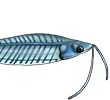update on the tiny gems:
they're about 1" now and growing, but extremely slowly!
anyone thinking baby petricola's are slow growers should try these; compared to Phyllonemus F1, petricola's are like bamboo

and they're by far THE most fragile catfish babies I've encountered.
I have 7 left of an original 15 or so, and 1 left of the second batch, because the parents decided to eat the other fry

they're very sensitive to waste, waterpollution, other fish, each other; you name it.
a surprise was the presence of 4 new baby Lophiobagrus brevispinis turning up in the breeding tanks as well; so those are also still going on.
new pics of baby Phyllonemus, wich were dropped by the parents during their tanktransfer. after reuniting them with their babies, they picked them up again, but after a few more days ate them, unfortunately.

these are very tiny, less than 1 cm.

you can still see the bellies, they're not eating yet.

typical catfish fry behaviour; they ball up together.

the youngster on the right shows whiskers already at this tender age, but a fairly large amount of yolk as well.
Phyllonemus has large yellow eggs, but few in number.




